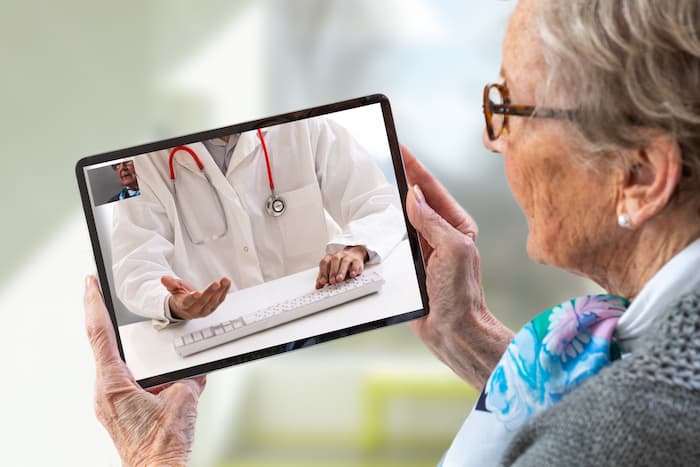By Naveen Kathuria, JD
More seniors took steps to become tech-savvier consumers during the first year of the pandemic, when expanded tech literacy put seniors in a better position to stay in touch with loved ones. Smartphone use among seniors reached an all-time high (42%), a Pew Trust research study found, and 67% had internet access.
Yet only a quarter of seniors feel confident using devices to go online, the study found. And, as many families of seniors know, just because a person owns a smartphone doesn’t mean they know how to use it effectively. More than half of seniors would like a better grasp of technology to connect more easily with others, and 37% do not feel confident using new technologies they purchased during the pandemic, an AARP survey found.
That’s why as more health plans—including Medicare Advantage plans—seek to integrate digital engagement solutions into their member offering, they have begun to recognize that family care involvement is critical to their members’ success in achieving improved health and well-being.
“Sandwich Generation” Crucial to Senior Tech Adoption
One of the biggest trends in senior care technology this year is the rapid rise in technologies to support the “Sandwich Generation”—adults who are caring for both their children and their aging parents—in navigating their parents’ care.
Nearly 53 million people provided unpaid care for adults in 2020, up 16.6% since 2015. Most caregivers are untrained, and they manage competing demands, from employment to other family responsibilities. During the pandemic, when competition for healthcare resources is stiff, tech-enabled supports provide a senior care lifeline for Sandwich Generation caregivers. They enable these adults to ask questions in the moment and receive a response from a trained health professional, easing the stress of making the right care decisions for their loved ones.
It makes sense, then, that family caregivers could play a vital role in engaging members in using digital tools to:
- Monitor their health, such as via health wearables
- Access virtual care
- Close gaps in care
How can health plans most effectively bring family members into the fold? We should consider the following three approaches.
Outline the value proposition of digital tech. When family members understand the value of digital tech for their older loved ones—such as the ability to boost mental health or improve access to care, they will be more apt to actively encourage its use. To bring family members on board, consider hosting a virtual onboarding session for members, and invite members to have family members participate as well. Offering a gift card for attendance, similar to the types of incentives offered for health and wellness initiatives, could lead to higher participation from members and family members who participate in their care.
Understand the types of technology seniors are likely to use with family caregivers’ support. Research by Deloitte puts seniors into three groups, each with unique health tech preferences: “trailing-edge boomers,” or younger Baby Boomers; “leading-edge boomers,” or older Baby Boomers; and other Medicare enrollees, or those 75 and older. Trailing-edge boomers are more likely to use voice assistants for reminders to take their medications (35%) or use a sensor that could predict the risk of heart attack or stroke (35%), but leading-edge boomers are not far behind. Another study by PWC found seniors 65 and older accounted for the largest proportion of telehealth users during the first months of the pandemic. By knowing the preferences of a specific age group, health plans also can anticipate the level of education and support that family caregivers may need in bringing seniors up to speed on digital tools and keeping them engaged.
Enable family members to be connected to digital technologies. This gives family members an inside view of the health data that are being tracked, where applicable, or the types of health reminders received. From there, family caregivers who are in charge of scheduling their loved ones’ appointments or communicating with physicians and other care professionals can take action. An even better resource for family caregivers: Offer real-time access to trained healthcare professionals, such as nurses or licensed social workers, for in-the-moment, tech-enabled support when care questions arise. This approach helps avoid unnecessary healthcare visits in expensive settings, such as the emergency department. It also gives caregivers greater confidence in helping to meet seniors’ complex care needs, creating a better experience for members and their families alike. Finally, it considers the impact on the health of the family caregivers themselves, as they have born the brunt of the burden of care responsibilities during the shift to aging in place. One recent study shows that 83% of caregivers reported increased stress and 46% experienced symptoms of depression during the pandemic.
By taking a family centric approach to digital tech adoption for seniors, health plans will be better positioned to secure higher levels of engagement from the members who most need these tools. It’s a more modern model for communication that enhances quality of care and health outcomes, reduces care costs and strengthens member and family satisfaction.
bio:
Naveen Kathuria, JD is the CEO of eFamilyCare.
The Editorial Team at Healthcare Business Today is made up of skilled healthcare writers and experts, led by our managing editor, Daniel Casciato, who has over 25 years of experience in healthcare writing. Since 1998, we have produced compelling and informative content for numerous publications, establishing ourselves as a trusted resource for health and wellness information. We offer readers access to fresh health, medicine, science, and technology developments and the latest in patient news, emphasizing how these developments affect our lives.








